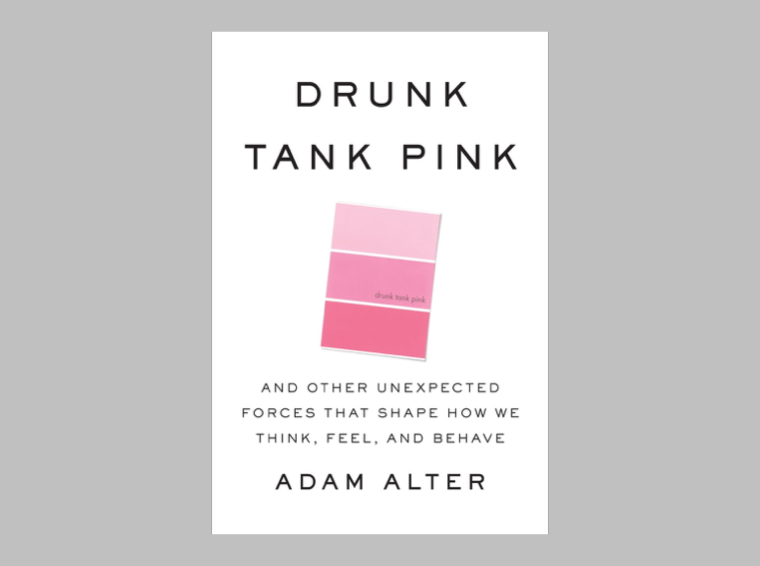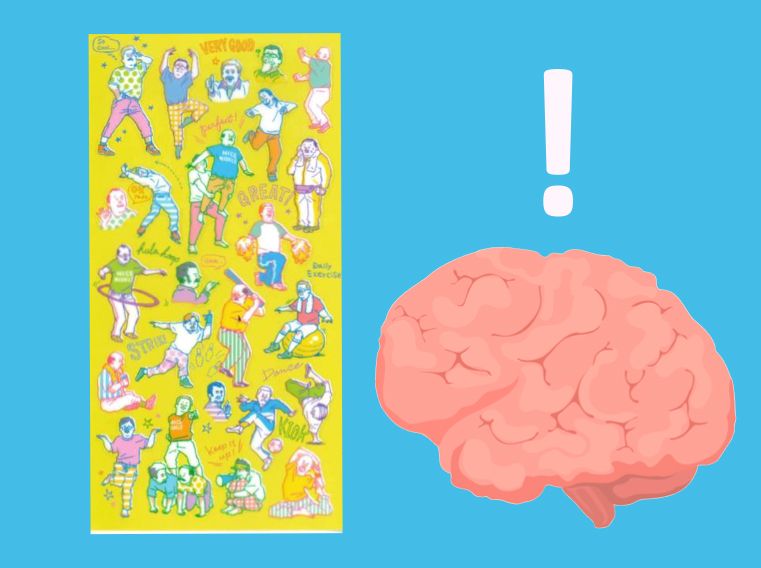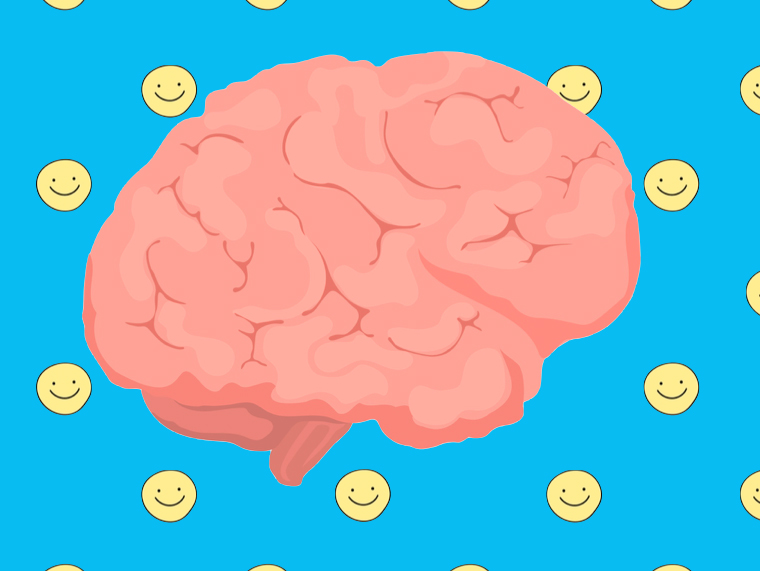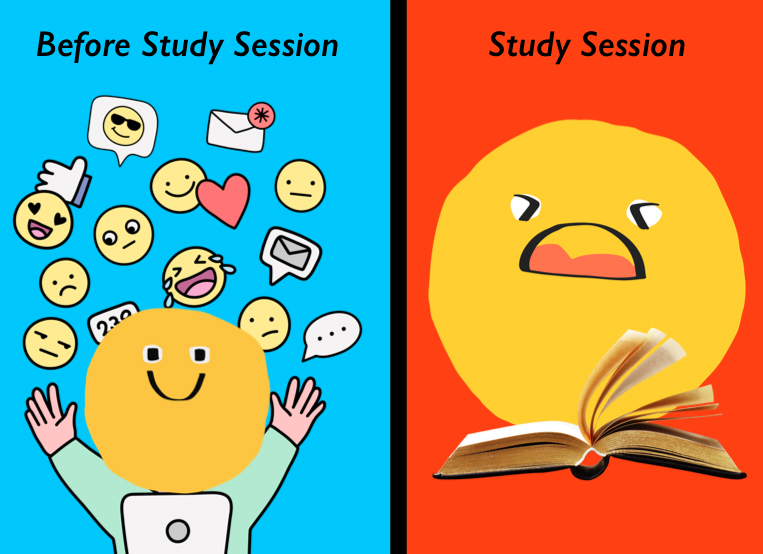I recently worked with a teenager girl who used a bright pink pen with a big diamond on top to take notes. This pen even had its very own feather bower.
Another student had a pencil case covered with a picture of a big fat pug dog. Pencil cases with multiple zips and pockets seem to be all the rage too.
Now I love stationery. But it’s the designer, overpriced and over-the-top stationery that I’ve started to question.
For instance, take a basic pencil case from kikki.K priced at a whopping $19.95. That’s right, $19.95!
Think of it like this: in terms of your time and energy, a fancy pencil case or notepad (priced at $20) is 1–2 hours of your life energy, slaving away at a job. You have to stop and ask yourself, ‘Is it really worth it?’
For less than $2, you could buy a simple exercise book and decorate it with pictures and ideas that mean something to you. In the past, I have done this with old comic strips, reused gift wrap and vintage magazines. All you need is access to some pictures, scissors, glue and a bit of clear contact to protect your creation (saving you over $15).
An obsession with fancy stationery can also deplete your willpower reserves and precious brainpower. It can even thwart the creative process. As author Fiona Scott Norman states,
“The more expensive, precious and important a notepad is, the less likely anything of note is going to ferment or foment between its pages. The stories of great creative minds writing their groundbreaking, best-selling works always run along the lines of: “I wrote it on table napkins in between my waitressing shifts” or “he bangs out all his novels on a poxy old typewriter”. They never go: “It all started when I bought a notepad made of horse hair and recycled 1950s children books at a design market”…these notebooks are not made to be used. Far too intimidating”
She goes onto say:
“The gorgeous journal, frankly, is the creative equivalent of the cross trainer ordered at midnight from the home shopping channel. It will end up in the spare room taunting you for your lack of discipline”.
As a recovering stationery addict, I can tell you that stationery can provide inspiration and motivation to study for about a day.
Then the inspiration wears off.
If you’re like me, I guarantee that you’ll get used to your pug dog pencil case. It won’t seem so cute on the second day (those bulging eyes will eventually start to bug you). And before you know it, you’ll be back to the stationery shop for your next hit.
In my early days of mind mapping, I purchased an exquisite set of 50 coloured pens. I thought “These pens will provide me with unlimited inspiration to mind map!”
Well, I was wrong.
I was happier and more productive when I just had a set of 6 basic colours.
Why would this be?
It all comes down to willpower depletion and the paradox of choice.
We all have a set amount of willpower and it gets depleted every time we have to make a decision.
I was rapidly draining my willpower reserves by agonizing over which colour I would use for my next mind map branch.
“The light shade blue or the slightly lighter shade blue? Or how about that pretty bright green?”
So I gave those pens away and returned to my basic colours.
The amount of time and energy you spend trying to find the perfect inspiring notebook or set of pens is time and energy taken away from you focusing on more important work such as preparing your mind for your upcoming subjects, exercising to sharpen your thinking and reflecting on your goals for the week.
My advice to you is this . . .
Productivity and organization expert David Allen (author of the bestselling book Getting Things Done: The Art of Stress-Free Productivity) says:
“ . . . good tools don’t necessarily have to be expensive. Often, on the low-tech side, the more “executive” something looks, the more dysfunctional it really is”
He suggests the basic stationery you need is as follows:
1. Paper-holding trays
2. A stack of plain paper
3. A pen/pencil
4. Post-it notes
5. Paper clips
6. Binder clips
7. A stapler and staples
8. Stickt tape
9. Rubber bands
10. Files
11. A calendar/diary
12. Rubbish bin/recycling bin
Extra tools I recommend are a set of basic coloured pens and art diaries (for visual note-taking), a couple of highlighters and a storage pouch for important documents so they don’t get damaged when you’re out and about.
If your fellow students or work colleagues are buying up big on fancy stationery, it’s probably a sign that they are struggling.
Whenever I used to go on a ‘stationery shop binge’ it was always because I felt stuck and/or uninspired by my work. The words weren’t flowing for an essay and/or I felt mentally overwhelmed by a subject.

But stationery will never give you a genuine boost in confidence. Stationery won’t make you smarter. It won’t help you overcome serious writer’s block.
The only way you can get unstuck is by doing the hard yards and nutting out your ideas by writing out your thoughts or mind mapping out your ideas. Any paper and pen will do the job. As Fiona Scott Norman says, even a napkin will do!
You might be thinking, “But what about decorating your study space? Surely, a nice study space will lead to elevated levels of creativity and productivity?”
The stationery superstore Officeworks now has an entire section dedicated to colour coordinating your study space. You can colour coordinate your notepads, desk lamp, pen holder, paper-holding trays, paper clips and files!
IKEA also presents you with examples of funky study spaces, displaying all the furniture and accessories to buy to maximize your study power.
But just know if you choose to go down this path, you may regret it. Denis Diderot certainly did.
In his essay, ‘Regrets on parting with my old dressing gown’, 18th century philosopher Denis Diderot describes the effect receiving a new scarlet dressing gown had on his life. Upon receiving the new beautiful gown, Denis decided to throw out his old gown. As he was walking around his apartment in his new gown, he noticed everything else looked old and drab in comparison.
Bookcases = Drab.
Table = Drab.
Chair = Drab.
So what did Denis do?
He threw out his old furniture and replaced it with brand new stuff.
The problem was, Denis didn’t feel comfortable in his new gown and with all his new furniture. The new chair wasn’t as comfy as his old one. He longed for his old gown and furniture. He realised the error of his ways, with every new purchase driving him to buy even more. His consumption was out of control.
The Diderot Effect is the term given to describes people’s desire for their items to match one another. But since every new purchase creates imbalance, one is forever consuming new items to achieve a state of balance. As Professor Juliet Schor states:
The purchase of a new home is the impetus for replacing old furniture; a new jacket makes little sense without the right skirt to match; an upgrade in china can’t really be enjoyed without a corresponding upgrade in glassware. This need for unity and conformity in our lifestyle choices is part of what keeps the consumer escalator moving ever upward. And ‘escalator’ is the operative metaphor: when the acquisition of each item on a wish list adds another item, and more, to our ‘must-have’ list, the pressure to upgrade our stock of stuff is relentlessly unidirectional, always ascending.
Having an understanding of the Diderot effect may help you to think twice before redecorating your study space or purchasing a new study chair.
Now I understand that everyone wants to work in a nice space. In terms of productivity, having a neat orderly workspace make a huge difference. But all you need to do is spend 30 minutes cleaning things up (e.g. removing clutter), add a pot plant and/or a simple picture to your wall. Boom! You’ve got a great new space.
The vast majority of items in my workspace are secondhand. My big L-shape desk came from Gumtree. My whiteboard from a skip bin. A bright colourful painting from a garage sale ($10). My files from a ‘Free – Please take’ box at university. Nothing matches but I don’t care. I’m comfortable in my workspace like Denis Diderot was before he received his new dressing gown.
So before you start spending up big for the new year, ask yourself “Is this new item a good use of my precious time and energy?” and “Is a new notepad the answer to my problems?”
Chances are the answer is “Probably not”.
Remember, it’s your ideas and work ethic that matters most. And you can’t buy those things at a stationery shop or IKEA.
Share This:

This is no accident. This is a deliberate design decision.
It’s the same reason why fast food logos are often warm reds, yellows, and orange tones. These colours jump out at us. They create a sense of excitement and urgency.
In his book Drunk Tank Pink, Dr Adam Alter argues colour is a hidden force in our lives that can shape the way we think, feel, and behave.

In this blog, I’m going to explore how you can use colour as a tool to help you study more effectively and keep your brain focused and engaged on the task at hand.
There is whole field of research dedicated to exploring the impact of different colours.
One fascinating study looked at the impact of a particular tone of pink (Baker-Miller Pink/Drunk Tank Pink) that appeared to sap people of their energy. Researcher Dr Alexander Schauss found staring at this shade of pink could lower people’s heart rate and pulse compared to staring at other colours.
A 7-month trial was conducted in which prison confinement cells were painted in this pink shade. According to Dr Schauss, when people were exposed for just 15 minutes to this pink colour in their prison cell, it made them more relaxed, less aggressive, and reduced the incidence of violent behaviour.

But before you race off to the hardware store to buy a tin of pink paint, you need to understand a few simple things about the psychology of colour.
The research suggests that colour can act as a powerful trigger. It can cue different emotions, thoughts, and behaviours. For instance, when you see a red Stop Sign or light, this captures your attention.
But how we react to colour also comes down to personal preference and particular contexts. Colour can have different meanings in different contexts (e.g., on Valentine’s Day red generally symbolises romance rather than “Danger! Look out!”).
The bottom line is this: when it comes to colour you need to experiment to see what works for you.
Colour can evoke particular states (e.g., a state of calm or alertness). It can also perk up your brain and transform a dry, boring subject into something that’s a little bit more novel and interesting for your brain.
Below I share 9 ways you can use colour to study and work more effectively.
There’s something about a brightly coloured post-it note that captures our attention. This is why I love using post-it notes to help focus my mind and stay on track.
On a post-it note, I create a list of no more than three things that I need to do. Once I’ve completed those tasks, I scrunch up the post-it and throw it in the bin. This action feels surprisingly satisfying! I’ll then grab a fresh post-it note (often in a different colour) to create a new list.
If I’m not sure how to get started with a task (e.g., Task: Write blog post on colour), I’ll grab another post-it note and I’ll scribble down the first tiny action I can take to kick-start the process (e.g., Tiny action: Open Word document).
If you have trouble finding your study materials for each subject and they all look the same or are scattered all over the house, you can use colour to make it easier for you to find what you need.
Try assigning a particular colour to a subject. This makes it easier to stay organised and identify your materials. At home, I assign a light blue to my exercise files and folders. When it’s time to plan my workout for the day, I look for my light blue files and folders.
A simple and cheap way to colour code your materials without investing in brand new stationery is to gather a collection of paint swatches from your local hardware store. You can repurpose these as labels by cutting them into smaller sections and sticking them on your files, notebooks, etc.
Testing yourself with flashcards is a highly effective way to study for a test and/or exam. You can create your own flashcard decks by purchasing index cards in a range of different colours.
Try assigning certain colours to different subjects. Alternatively, you can simply pick a colour you want to work with depending on how you feel.
There are no hard and fast rules. Feel free to mix up your flashcard colours to keep things fresh for your brain.

Creating a mind map on a topic is a simple way to combat study fatigue and inject a little colour and creativity into your study sessions.
Although using different coloured pens isn’t absolutely essential for mind mapping, it’s well worth doing. I use different colours to create the different branches on my mind maps.
I have dozens of colourful mind maps at home. Despite my lack of drawing skills, these mind maps look great and are fun to review primarily due to the different coloured branches.
It’s important that you feel good in your study environment. If you feel good in your study space, you’re more likely to sit down and study there.
I’ve decorated my workspace by putting up colourful posters, inspiring and funny pictures, and artwork on my walls.
If you don’t have access to artwork/posters, you can print out colourful pictures and quotes of things that make you feel good. The addition of a few indoor plants can also help to liven up your space as well as purify the air.
Fluorescent highlighters feel really good to use. It can feel both fun and satisfying to strike things off your to-do list. You can also use these pens to time block different tasks/events in your diary and draw your attention to important tasks that you need to do.
Word of warning: When it comes to studying for a test or exam, I don’t recommend highlighting your books and/or notes as a way to learn. I know it feels good but research shows it’s an ineffective way to learn.

Red pen is often associated with failure and criticism. This is why seeing a teacher’s comments scribbled in red pen can trigger negative emotions in many of us.
Generally, we don’t like reading comments written by others in red pen. It feels nasty! But it turns out if you use a red pen to correct your own work, this can help you to pick up more errors.
Dr Adam Alter discusses one study that looked at the difference between using a blue pen and a red pen to correct an essay. Students who used a blue pen picked up on average 19 errors. In contrast, students using a red pen picked up an average of 24 errors.
But using a red pen has its limitations! If you are trying to solve a problem or taking a test, using a red pen can backfire by activating ‘avoidance motivation’. This is a distracting state of mind that can impair a student’s ability to solve problems and increase stress levels.
As a rule of thumb, use a blue or black pen when solving problems and taking tests. But when you need to cast a more critical eye on your work (e.g., in the proofreading phase), switch to using a red pen.
A lot of us use our phones as an easy way to escape from the boredom and discomfort we experience when doing our work. The apps on our phones are like candy. They are designed to be highly addictive and hijack our attention.
This is where you can be strategic with how you use colour: you can make your phone look more like a tool (and less like a toy) by turning on greyscale mode.
Viewing your phone in greyscale is a completely different experience to using it in full-colour mode. As a year 8 student recently shared with me:
“When I made my phone greyscale, it made it really boring to use.”
Try it and see for yourself!

This strategy may seem juvenile. If it reminds you of being back in primary school and receiving gold stars, hear me out.
Too often we don’t stop to acknowledge and appreciate ourselves for accomplishing tasks. We finish one thing and we immediately shift our focus to the next task on our to-do list.
When you work this way, your work routine can quickly become soul destroying and your motivation can take a dive.
This is why every so often I pull out my fun stamps and colourful sheets of stickers. After completing a task, I pause and acknowledge what I’ve done by giving myself a stamp or a fun sticker. It’s a little celebration.
For some reason, my brain responds particularly well to quirky Japanese stickers featuring ogisan (Japanese grandfathers) exercising. We’re all different, so explore what stamps and stickers work for you.
Colours are lot of fun! Incorporating a little more colour into your studies and work life can take things to the next level and perk up your brain when it needs a little motivational boost.
But the colours that I like may not be the colours that you like. Your colour preferences may also vary from day to day. Notice the colours that make you feel good and have fun seeing how you can incorporate them into your study sessions.

About 10 years ago I met the beloved Australian celebrity Costa Georgiardis from the television show Gardening Australia.
I was blown away by Costa’s energy and enthusiasm.
He was exactly like he appeared on TV. But he wasn’t hamming it up for the camera. Costa was the real deal.
He was high on life.

I’ve heard that people often ask Costa “Why are you so energetic?”, “Why are you so up?”, and “Don’t you get tired?”
Some people feel tired just being around Costa (check out this video to get a sense of Costa’s energy).
What’s the difference between motivated and energised people and less motivated people who struggle to get off the couch?
According to Stanford professor Dr Andrew Huberman the difference has everything to do with dopamine.
In this blog post, I want to explore how dopamine works and how you can adjust your dopamine levels to experience more motivation, focus, and energy in a safe and healthy way. Let’s go!
Dopamine is a neurotransmitter that is involved in reward processing. Your brain releases this molecule whenever it anticipates a reward.
In a healthy brain and environment, dopamine plays an important role in keeping you motivated, focused, and on track with your goals.
Unfortunately, this natural feedback system can be hijacked by big tech companies and fast food corporations.

Tonic dopamine is your baseline level of dopamine that circulates through your system. People who are generally enthusiastic and motivated have a high baseline dopamine. But if you struggle with motivation and often feel lethargic, chances are you have a low baseline dopamine.
But then there’s phasic dopamine. This is where you experience peaks in dopamine above your baseline level. These peaks occur as a result of engaging in certain behaviours and/or consuming certain substances.
For example, social media companies train users to seek out quick, easy, and frequent hits of dopamine. Fast food companies engineer foods that have just the right amount of salt, fat and/or sugar to release big spikes in dopamine. This make you want to eat more of the food product and keep going back for more.
It’s important to understand that these peaks in dopamine don’t last.
After engaging in a dopamine-rich activity, you will experience an inevitable drop in dopamine. And this drop will be below your baseline level.
It should come as no surprise that when you’re in a dopamine deficit state you don’t feel very good. You experience pain and discomfort.
According to Psychiatrist Dr Anna Lembke this is our brain’s way of trying to bring everything back into balance and establish homeostasis.

In the book Dopamine Nation Dr Lembke talks about how pleasure and pain are experienced in overlapping regions of the brain. She states:
“Pleasure and pain work like a balance”.
If you tip to the side of pleasure or pain, self regulatory mechanisms kick in to bring everything back into balance.
But you never want to tip to one side for too long. Dr Lembke states:
“With repeated exposure to the same or similar pleasure stimulus, the initial deviation to the side of pleasure gets weaker and shorter and the after-response to the side of pain gets stronger and longer, a process scientists call neuroadaptation . . . we need more of the drug of choice to get the same effect.”
In other words, consuming more of a dopamine-rich substance or behaviour is bad for your brain. It will leave you in a dopamine-deficit-state.
And when you’re in this state, it’s much harder to do your school work.
There are a number of simple things you can do to regenerate your dopamine receptors and increase your baseline dopamine. I’ve listed several strategies below.
Before you start your work or study, you want to avoid engaging in activities that will cause spikes in dopamine. If you watch TikTok videos or play video games before sitting down to do your homework, this is going to make your work feel a lot more painful and boring.

Here’s why . . .
Dr Huberman states that how motivated you feel to do a task depends on your current dopamine levels and what previous peaks in dopamine you have experienced. This is important to understand because with this knowledge, you can create routines and habits to conserve your dopamine and motivation for pursuing your goals.
With this in mind, I’ve recently simplified my morning routine in the following ways:
• I don’t start the day by looking at my phone or computer
• I exercise without listening to music
• I have a healthy breakfast of overnight oats and berries rather than a super sweet smoothie
• I have a cold shower (more on why I do this below)
Whilst this may sound boring, it’s had a dramatic impact on how easy it is for me to get stuck into doing my work.
The term ‘Dopamine Detox’ is a little misleading since it’s technically not possible to detox from dopamine. Nevertheless, the idea is a good one.
When you engage in a dopamine detox, you’re taking a break from engaging in dopamine-rich activities (e.g., consuming junk food, going on social media, and watching Netflix). This will give your dopamine receptors a chance to regenerate.
After taking a dopamine detox, you’ll probably notice that simple things like eating basic wholefoods or going for a walk are much more pleasurable. As Dr Huberman points out:
“Our perception for dopamine is heightened when our dopamine receptors haven’t seen much dopamine lately.”
Research shows that cold water therapy (i.e., being submerged in cold water) can increase your dopamine by 250% above your baseline level.

Let’s put that in context:
Chocolate increases dopamine by 150% above baseline
Alcohol increases dopamine by 200% above baseline
Nicotine increases dopamine by 225% above baseline
Cocaine increases dopamine by 350% above baseline
Amphetamines increases dopamine by 1100%
You need to remember that these peaks in dopamine are followed by a sudden crash below your baseline level. Let’s not overlook the fact that chronic substance abuse causes brain damage and can be fatal.
Unlike other addictive substances, cold showers create peaks in dopamine that can last for several hours. You also don’t experience the subsequent dramatic crash below your baseline level.
Word of warning: Before you turn on the cold shower tap or start running an ice-bath, it’s important to be aware that people can go into shock when plunging themselves into cold water. Please be careful!
If cold showers aren’t really your thing, try increasing your dopamine with exercise. Exercise has been found to increase dopamine by 130% above your baseline level.
In the book Move The Body, Heal The Mind, neuroscientist Dr Jennifer Heisz says:
“Exercise increases dopamine and repopulates dopamine receptors to help the brain heal faster during recovery [from addiction]. Although all forms of exercise can do this, runner’s high may do it best.”
Look for ways to make it harder to engage in the dopamine-rich activities. Create barriers and/or friction points to stop you from mindlessly seeking quick shots of dopamine.
For example, I recently noticed I had a problem with compulsively checking my phone. Whenever I felt bored or lonely, I’d check my phone to see if I’d received any messages. I didn’t like the fact I was doing this but I found it hard to stop. What could I do?
I could use a dumb phone.
I found a ‘seniors’ flip phone that allowed me to do basic things like make calls and send texts. But sending texts is not easy! I have to type in each letter and change from upper to lower case. It really puts you off wanting to text your friends.
Since switching to a dumb phone, the number of times I touch my phone each day has significantly decreased.

As you do your work, praise yourself for the effort you’re putting in. Doing this can increase the dopamine you have for the activity.
Dr Huberman suggests saying the following while you’re doing painful work:
“I know this is painful. But you need to keep at it. Because it’s painful, it’s going to increase my dopamine later and I’m doing this by choice.”
We live in a dopamine-rich world. It’s so easy to flood your brain with quick hits of dopamine that feel good in the moment but leave you feeling flat and irritable shortly after. These peaks in dopamine make it harder for us to pursue our goals by undermining our motivation.
No matter what your current dopamine baseline is, just remember this: you have the ability to increase your dopamine in a healthy and sustainable way. Kick-start the process today!
I love the feeling.
I think, “Go me! Look at you go!” as I strike the pen through the list item.
But as good as it feels to cross things off, it’s not really about that. That’s not where the power of lists resides.
The power exists in making the list in the first place. Getting the thoughts out of your head and down on paper.
In his book Keep going: 10 ways to stay creative in good times and bad Austin Kleon states:
“Lists bring order to the chaotic universe. I love making lists. Whenever I need to figure out my life, I make a list. A list gets all your ideas out of your head and clears the mental space so you’re actually able to do something about them.
When I’m overwhelmed, I fall back on the old-fashioned to-do list. I make a big list of everything that needs to get done, I pick the most pressing thing to do, and I do it. Then I cross it off the list and pick another thing to do. Repeat.”
When I’m feeling really under the pump, I’ll go for a walk and scribble out a list while I’m walking.
I’m not sure which activity helps me more – the walking or the list making – but by the time I arrive home from my walk, I always feel less anxious and more in control.
If you haven’t been having much luck with to-do lists, you may have fallen into one of the following common traps:
If you look at your list and it says says things like ‘Mum’s birthday’ or ‘Study’, it’s time to make these list items crispy.
Crispy is a Behaviour Design term created by Stanford university Professor BJ Fogg. When you make a behaviour crispy, you get really clear on the specific behaviour you need to carry out.
Here are some examples I came up with to illustrate the difference between fuzzy and crispy list items:
Fuzzy to-do list item: Mum’s birthday
Crispy to-do list item: Call mum to wish her happy birthday after lunchFuzzy to-do list item: Study
Crispy to-do list item: Open Quizlet study deck and test myself for 5 minutes on the bus
When you ‘crispify’ a list item, you tighten it up. You make it crystal clear for your brain what you need to do next. This in turn makes it much easier for you to get started.
If your list is no longer working for you, feel free to abandon it and create a new one. As Psychiatrist Douglas Puryear says in his book Your life can be better:
“I make lists over and over, all day long. It’s not just about having the list; there is also benefit in making them. Writing down what I need to do is somehow calming and organizing, and therefore motivating. When I write things down, it’s as though I’m on top of them.”
Our brains get bored easily, so try making your list a little bit different every now and then.
Here are some simple ideas on how you can jazz up your next to-do list:
It doesn’t matter what medium or what materials you use to create your to-do list. What matters is that you get everything out of your head and you make each list item crispy.
If your to-do list is causing you to have a mini meltdown, back up. Ask yourself . . .
“Is this list too long? Can I cross a few things off?”
Create a short list from your big list – just three items (post-it notes are good for this). Then put away your long list. When you’ve completed those three items, create a new list of three from your long list.
During times of chaos, lists are your friends. Reach out and use this fabulous tool to lighten your mental load. You don’t need any special skills or talent to do this. Lists are for everyone.
Dr Jane Genovese delivers interactive sessions on learning to learn, combating procrastination, exam preparation, how to focus in the age of distraction, habit formation and much, much more!
Get FREE study and life strategies by signing up to our newsletter:
© 2024 Learning Fundamentals